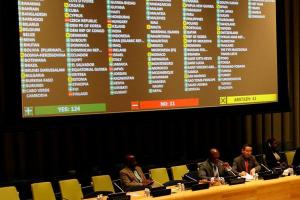On September 10, 2015 during its 69th sessions, the United Nations General Assembly adopted a resolution entitled “Basic Principles on Sovereign Debt Restructuring Processes” (A/69/L.84), which seeks to improve the global financial system.
The purpose of the rule, as stated in its introductory paragraphs, consists of creating “a clear set of principles for the management and resolution of financial crises that take into account the obligation of sovereign debtors and their creditors to act in good faith and with a cooperative spirit”.
The draft resolution was proposed by Argentina and submitted by South Africa on behalf of G-77 + China. 136 countries voted in favour of the adoption of the resolution while 6 voted against and 41 abstained.
The resolution outlines nine Basic Principles designed to rule the debt restructuring processes, which were agreed on through a transparent multilateral negotiation held at the United Nations Ad Hoc Committee on Sovereign Debt Restructuring.
The nine Principles included in the resolution, which now form part of the international law, are: the sovereign right of states to restructure their debts, good faith, transparency, impartiality, equal treatment among the creditors, sovereign immunity of the states, legitimacy, sustainability and majority restructuring.
From now on, we will go over some of these Basic Principles:
. Sovereign right of states to restructure their debts: “A sovereign state has the right (…) to design its macroeconomic policy, including restructuring its sovereign debt, which should not be frustrated or impeded by any abusive measures”.
. Good faith: Debtors and creditors “should act in good faith and with a cooperative spirit to reach a consensual rearrangement” of the sovereign debt. Such good faith implies that negotiations towards debt restructuring should be “constructive” and pursue the aim of “a prompt and durable re-establishment of debt sustainability”.
. Sovereign immunity of the states: “Sovereign immunities from jurisdiction and execution regarding sovereign debt restructuring is a right of states before foreign domestic courts and exceptions should be restrictively interpreted”.
. Sustainability: Debt restructuring should “lead to a stable debt situation (…) preserving at the outset creditors’ rights while promoting sustained and inclusive economic growth” of the debtor country.
. Majority restructuring: “Sovereign debt restructuring agreements that are approved by a qualified majority of the creditors of a state are not to be affected, jeopardized or otherwise impeded by other states or a non-representative minority of creditors, who must respect the decisions adopted by the majority of the creditors”.
Background:
In 2002, Argentina incurred a default of $100 billion amid a severe economic crisis.
Subsequent governments adopted various measures to normalize the country’s international financial relations, a process during which Argentina cancelled its entire debt to the International Monetary Fund, World Bank and the Centre for Dispute Resolution arising from Investment Disputes (ICSID).
This policy allowed that after a decade of the declaration of default the shares of public debt denominated in foreign currency went down from over 120% to less than 8% of the GDP.
Also, during the process and after lengthy negotiations, a debt swap agreement was agreed with 92.4% of all individual bondholders of the defaulted debt, which amounted to $81,000 million.
After the agreement, Argentina punctually made all payments on restructured debt, even though the country was still locked out of the international financial market.
One of the keys that enabled the agreement was the commitment of Argentina not to offer the 7.6% of creditors who rejected the swap (houldouts) in the future better terms than those granted to the 92.4% of acceptors.
According to this commitment included in the signed agreement, if Argentina ever paid the 7.6% more than the amount paid to the 92.4%, the latter were entitled to claim equal treatment.
Of the 7.6% of bondholders who rejected the swap, hedge funds NML and Aurelius (1% of that total) sued the country before various international courts in order to force Argentina to pay them the face value of the bonds.
It is worth mentioning that these holdouts never lent money to Argentina or paid the face value of the bonds but they bought the bonds at a cheap discount, after the default.
They did it presumably with the sole purpose of engaging into litigation against Argentina and earn an exorbitant profit, which is why they are known as “vulture funds”.
Their numerous lawsuits failed until a judge from a New York court – Thomas Griesa – issued a ruling ordering Argentina to pay NML and Aurelius the face value of the bonds: $ 832 million, which entails a gain of 1608% for the litigants.
Argentina refused to comply with this ruling, and appealed, claiming that if it paid the vulture funds that amount all other creditors – for the reasons explained above – would become entitled to demand payment of the entire debt – $120,000 billion –, which would have ripped up the restructuring agreement reached.
To issue this ruling, Griesa resorted to a principle included in the debt restructuring agreement, called pari passu, which orders equal treatment to all creditors who accepted the agreement.
However, the judge made a distorted application of the principle since he extended it to the creditors who rejected the agreement, whereas in fact it was confined to the creditors who accepted the swap and signed the agreement.
As part of this controversial interpretation, Griesa decided that, because Argentina was paying to other creditors (acceptors), it must also pay the holdouts, and it must pay them the total amount of the debt because they had not accepted the swap.
In another unprecedented move, the US Supreme Court on June 2014 declined Argentina's appeals and confirmed the ruling of judge Griesa, who then ordered our country to comply with his decision before July 30.
Under the domestic legislation of any country, if 66% of the creditors reach an agreement with the debtor after a default, the other creditors must respect the agreement, but there is no similar international regulatory framework applicable to cases in which the debtor is a sovereign state.
This legal loophole – in light of rulings like the one issued by judge Griesa – poses a serious threat to the international financial system because it entails that, even when 99.9% of the creditors accepted a sovereign debt restructuring agreement, a 0.1% who opposed it may invalidate the restructuring.
For this reason, Argentina proposed in August 2014 that the United Nations General Assembly create an international legal framework to prevent future creditors of this kind to undermine sovereign debt restructuring agreements. This proposal received the support of most countries in the world.
On September 8, 2014 the mentioned international legislative body called to begin work towards the adoption of the international legal framework proposed by Argentina. To this end, it created the Ad Hoc Committee on Sovereign Debt Restructuring.
For a year, the Ad Hoc Committee held three formal meetings and numerous informal gatherings in which states agreed on the wording of the nine Basic Principles. International financial institutions participated in the meetings as observers.
Argentina welcomes the issuance of this resolution by the most democratic and representative organ of the United Nations – the General Assembly – since this is a clear signal of its commitment to achieve an efficient, stable and predictable international financial system.



